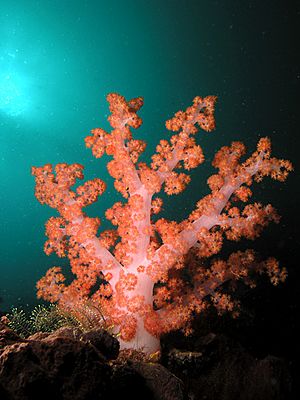Octocorallia facts for kids
Quick facts for kids Octocorallia |
|
|---|---|
 |
|
| Dendronephthya klunzingeri | |
| Scientific classification |
|
| Kingdom: | Animalia |
| Phylum: | Cnidaria |
| Class: | Anthozoa |
| Subclass: | Octocorallia Haeckel, 1866 |
| Orders | |
|
|
| Synonyms | |
|
|
Octocorallia are a special group of sea animals. They are a type of Anthozoa, which are part of the Cnidaria family. This family includes jellyfish and sea anemones. There are more than 3,000 different kinds, or species, of Octocorallia.
Most Octocorallia live together in groups called colonies. They are usually sessile, meaning they stay in one place. Each animal in the colony is called a polyp. These polyps have a unique feature: they always have eight tentacles. This is why they are called "octo" (meaning eight) corals.
Contents
What Makes Octocorals Special?
Octocorallia look a bit like stony corals. However, stony corals are different. They have six tentacles, not eight. Stony corals belong to a group called Hexacorallia.
No Reef Builders
One big difference is that most Octocorallia do not have a hard, lasting skeleton. Stony corals, on the other hand, build strong skeletons. These skeletons create the huge structures we know as coral reefs. Because Octocorallia lack this hard skeleton, they do not help build coral reefs. An older name for this group of animals is Alcyonaria.
Living with Others
Many Octocorallia species have a special relationship called symbiosis. They live with tiny, single-celled algae. These algae live inside the coral polyps. The algae make food using sunlight, and the coral uses some of that food. In return, the coral provides a safe home for the algae.
Staying Safe
Octocorallia have many animals that might want to eat them. To protect themselves, many of them are toxic. This means they have a natural poison. Or, they might just taste really bad to predators. This helps them stay safe in the ocean.
How They Reproduce
Many Octocorallia species can make new corals in two ways. They can reproduce sexually or asexually.
Sexual Reproduction
In sexual reproduction, two parents combine their genetic material. This usually involves eggs and sperm. It's common to find a colony where most of the polyps are either male or female.
Asexual Reproduction
Asexual reproduction means a new coral grows from just one parent. This can happen in different ways. For example, a piece of the coral might break off and grow into a new colony. This helps the colony grow and spread quickly.
Images for kids
-
Full corallum of Tubipora musica.
See also
 In Spanish: Octocorales para niños
In Spanish: Octocorales para niños


